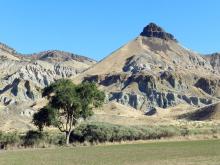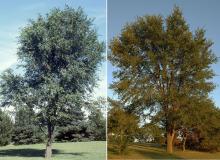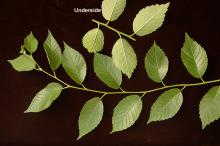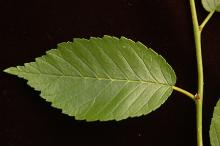Ulmus pumila
Common name:
Siberian Elm
Pronunciation:
UL-mus PU-mi-la
Family:
Ulmaceae
Genus:
Type:
Broadleaf
Native to (or naturalized in) Oregon:
No
- Broadleaf deciduous tree, 50-70 ft (15-21 m) tall, its width about 3/4 its height, open habit, brittle, pendulous branches. Leaves simple, alternate, 3-8 cm long, 0.8-3+ cm wide, elliptic to elliptic-lanceolate, nearly equal at the base, usually simply serrate, dark green and smooth above, glabrous below, petiole tinged dark red. Flowers appear before leaves, inconspicuous, green. Fruit about 1 cm, almost a round disk, a closed notch at the tip of the wing.
- Sun. Very adaptable, often grows under adverse conditions. Resistant to Dutch elm disease. Frequently used as a hedge in rural areas, but generally considered a poor ornamental tree, mostly because of its weak branches, messy habit, and susceptibility to insect attack, especially leaf beetles. Extensively planted in the 1930s. Sometimes sold as Chinese Elm, a name that is also used to identify Ulmus parvifolia, a superior ornamental tree, which, to avoid confusion, is now sold as Lacebark Elm.
- Hardy to USDA Zone 4 Native to eastern Siberia, northern China, Manchuria, and Korea.
- pumila: dwarf, according to Jacobson (1996) the botanically typical form of the species is a small-leaved shrub of eastern Siberia and Mongolia (hence dwarf). However, the form in northern China, Manchuria, and Korea is a tree.








